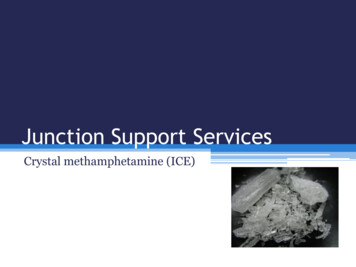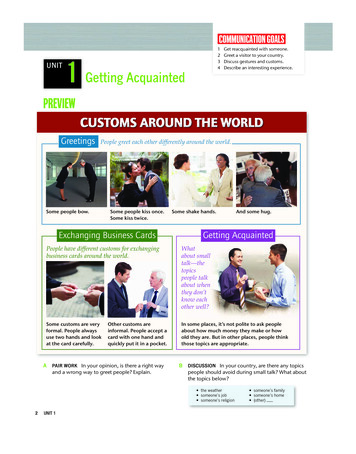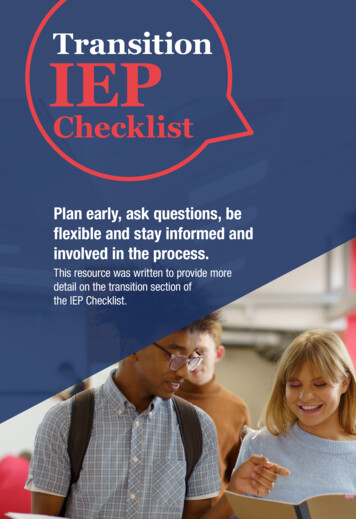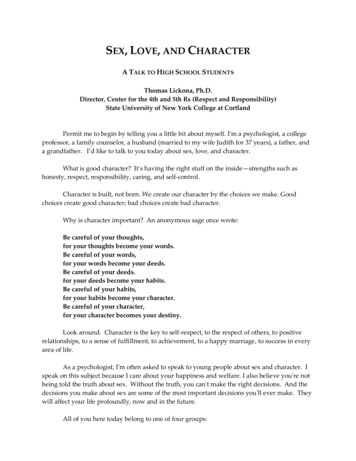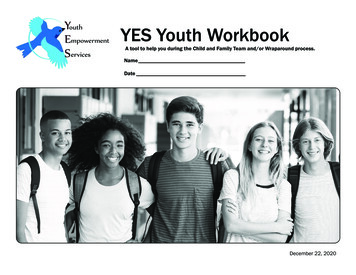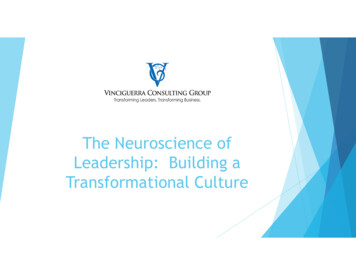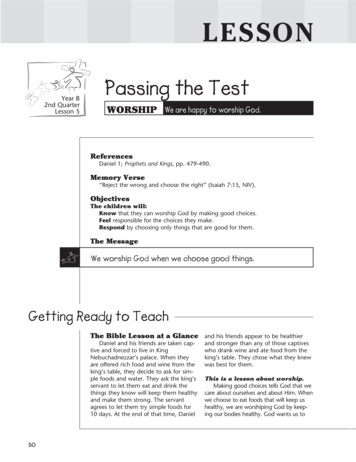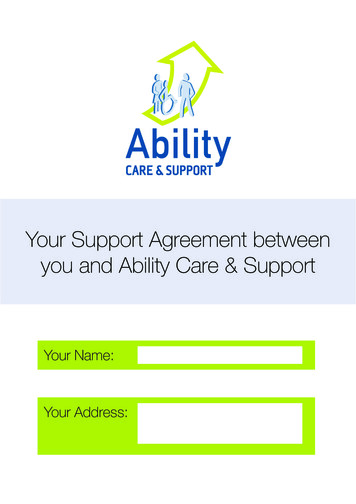
Transcription
FAQQ: What do you do on the International Space Station (ISS)?A: Astronauts and cosmonauts on the space station stay busy. There’s lots of work to operatethe many science experiments on board. The crew also has to make sure that the station is in topshape, so they clean, check equipment, maintain and repair or replace broken equipment. Crewmembers also must exercise two hours each day to stay fit and keep their bones and musclesstrong. Sometimes we need to do a spacewalk to work outside the station in our space suit. It’s atough and dangerous job but the view is terrific. The extra-vehicular activities, or EVAs, help keepthe space station running.Q: How fast and how high do you go?A: The space station travels through space at 17,500 miles per hour at an altitude of about 220miles. We orbit the Earth about once every 90 minutes. During the orbit of the Earth we are indaylight for about 45 minutes and darkness for about 45 minutes. That means the sun will rise andset 16 times a day. You can see the space station from where you live at certain times. Visit http://www.jsc.nasa.gov/sightings/index.html to find out when you can see the ISS.Q: How long are the missions?A: The ISS missions, called expeditions, usually last about six months. There are three to sixcrewmembers on board at all times. Professional astronaut crews come from the U.S., Russia,Japan, Canada and Europe. NASA astronaut Mike Lopez-Alegria has flown the longest U.S. spacestation mission to date, at 215 days. Valeri Polyakov, a Russian cosmonaut, spent 437 days inspace during one mission. A space shuttle crew is typically five to seven crewmembers. We havecarried as few as two and as many as eight at one time, and space shuttle missions have been asshort as two days and as long as 18 days.Q: What does a launch feel like?A: In a Russian Soyuz capsule, which is how astronauts who are part of expedition missions getto the space station, three people are crammed into a small space. The crew gets in the Soyuzabout two and a half hours before launch. Once the crew is all strapped in, they perform a seriesof pre-flight checks of all the Soyuz systems. When the checks are finished, the crew waits whileworkers on the launch pad do the final rocket preparations.Shortly before the time of launch you start hearing different noises below you and you know thingsare getting ready to happen. Then, it is as if a giant beast is waking up. You hear and feel thethumping and bumping of valves opening and closing as engine systems are pressurized. Whenthe first engines light there is a terrific low frequency rumbling and things start to shake. Then themain engine lights and the rumbling and shaking get even louder. Slowly, slowly you begin to moveup and away from the launch pad. But, very quickly you build up speed and the g-load, or the forceof gravity or acceleration on a body, increases. You shake and rattle along and then there is a bangwhen the rescue system is jettisoned, another bang when the four strap on boosters separate,and another bang when the nose faring comes off. Now the windows are uncovered and you cansee light coming in. At the second stage separation there is another bang and the g-load dropsimmediately. You go from about four and a half g’s down to about one and a half or two g’s. Thenthe third stage engine lights; you have a big push forward and the g-load builds again.Eight and a half minutes after launch there is a loud bang and jerk and the last section of the rocketis jettisoned from the Soyuz spacecraft. And just like that, you are there–in space. It feels like youare hanging upside down in your shoulder harness. This is simply because there is nothing pushingyou back into your seat anymore. Everything floats, including you.
FAQIn the space shuttle, astronauts are strapped in on their backs a few hours before launch. As themain engines light, the whole vehicle rumbles and strains to lift off the launch pad. Seven secondsafter the main engines light, the solid rocket motors ignite and this feels like a huge kick frombehind. The vehicle shakes a lot and the ride is rough for the first two minutes as you are pressedback into your seats with twice your weight. When the solid rocket motors burn out there is abig flash of light as they separate from the big fuel tank the shuttle is strapped to. Then the ridesmoothes out. As you get higher into the thinning atmosphere and burn off most of the fuel, thevehicle accelerates faster and you are pressed back into your seat with three times your weight forthe last two and a half minutes of the ride. This two and a half g’s feels like a giant gorilla is sittingon your chest making it more difficult to breathe. Eight and a half total minutes after liftoff, the mainengines stop and immediately you go from the being squashed by the gorilla to being weightless.Astronauts practice for launch frequently during training. We work in a simulator that mimics thenoise and shaking of launch, but cannot mimic the acceleration and speed of a real launch. We arebusy monitoring the shuttle systems during launch, but still have time to enjoy the feeling of goingfrom 0 miles per hour to 17,500 miles per hour in eight and a half minutes.Q: Where do you go in the Space Shuttle? Do you go to the moon?A: The Space Shuttle orbits the Earth at an altitude of 120-300 miles. We fly the shuttle to theISS where we dock and continue work onboard the station. In the past we have taken the shuttle tothe Russian MIR space station, and we have used it to visit the Hubble Space Telescope for on-orbitrepairs. Today, from our orbit above the Earth, we are in a good position to study the stars, studythe Earth, perform experiments, build and resupply the ISS, and learn how to live and work in theabsence of gravity.The shuttle is not designed to go to the moon. It has never carried enough fuel to get to the moonand back, and, since there is no atmosphere on the moon, the wings would be of no use, andthe shuttle could not land. We last visited the moon with American astronauts during Apollo 17in 1972. Currently, NASA is developing a new rocket and a new space craft that will take peopledeep into space.Q: How long do you have to train before you fly in space?A: Astronauts are in constant training for space flight. The initial training involves learningabout basic space station systems, space walking, and operating the robotic arm. You continuethis training while awaiting a mission assignment. Once assigned to a flight, specific trainingfor your mission may take as long as three years. The length of training depends on howcomplicated the tasks are on your mission. ISS missions require that you speak Russian, whichadds time to your training.Q: What effects does space flight have on your body?A: A ‘normal’ body will adapt to the ‘abnormal’ environment of space in many ways. Immediatelyupon entering zero gravity, fluids in your legs and the lower part of your body move upwardstowards your head. In fact, your face will feel and look swollen. Except for the occasional headacheand congestion, astronauts aren’t bothered by this fluid shift. Some astronauts feel dizzy and havean upset stomach during the first few days of a space flight as they get used to zero gravity. Thisfeeling usually goes away after three or four days. After a few days almost everyone is used to zerogravity and feels great. If you don’t exercise, your bones and muscles will get weak. Upon return to
FAQEarth, you must get used to gravity again. Sometimes this makes you feel dizzy or queasy. If youare returning from a two week flight, readjusting might take a day or two. If you are returning froma six month flight, it may take several weeks to feel ‘normal’ again.Q: What do you do when you aren’t on a mission?A: When astronauts are not flying on a mission or training for a mission, they support othermissions. There are many jobs on the ground required to support the design, preparation,training and flying of a space mission. Astronauts work in mission control (the ‘voice’ thatcommunicates with astronauts in orbit), check out procedures and the checklists the crew inspace will use, help verify the space station and vehicle software, develop procedures and toolsto be used during spacewalks or robotic operations, help scientists in developing experimentsthat will be run in space and perform other jobs in support of ISS and vehicle flights.Q: What kind of food do you eat?A: We bring along several different types of food when we fly in space. Since we don’t have afreezer, refrigerator, stove or microwave, most of the food has already been cooked, then freezedried and vacuum packed (meaning the water and air has been taken out of it), or it is thermallystabilized (meaning treated and sealed in a package to prevent spoiling), much like campingfood. These packages of freeze dried food can be reconstituted by adding water and thenwarmed up in a small warming oven.We don’t want food that makes crumbs in space since crumbs would float all over the place andthat could clog up equipment! Peanut butter, in fact, is the nearly perfect space food. It has nocrumbs and almost everyone loves peanut butter. We can bring fresh foods with us, as long aswe eat them early in the mission before they spoil.Q: How do you go to the bathroom in space?A: The space potty is a little different than the Earth potty. First of all, to keep from floatingaway, you must use foot-loops or straps while ‘sitting’ on the seat. This holds you on to theseat, sort of like a seat belt. Secondly, the space potty uses suction, not water, to ‘flush.’Q: Do you watch TV? What do you do for fun?A: The space station crews can ask mission control to send them shows that they can watchduring dinner or off-duty time. They can also watch movies on their laptops. They may bringbooks, music, and musical instruments with them. Some astronauts enjoy hobbies, such asdrawing, photography, and HAM radio.During missions, astronauts are very busy. The few hours of free time may also be spentlooking out the window at the beautiful Earth below, listening to music, surfing the web, orcorresponding with friends and family back home.Q: Can you call your family? Do you have email?A: Until a few years ago, we were not able to communicate easily with people on the groundoutside of mission control. Now, we can send email to our friends and family directly, and wecan make phone calls using a hook-up through our computer. The phone connection is reallyclear: You’d never know we were calling from space. Many astronauts carry pictures of theirfamily with them on space missions.
FAQQ: Are you scared to fly in space?A: A very experienced astronaut who has flown every space vehicle from Gemini to the shuttleonce said that if you are not just a little afraid, you don’t know what’s happening. Astronautsare well aware of the risks involved in space travel. We are willing to take these risks becausewe believe in the mission of space exploration and we think the risk is well worth the benefit.Though these risks can make us nervous at times, when we are flying, we don’t let thenervousness interfere with doing our jobs.Q: What do you do if you get sick in space?A: We carry first aid kits and some special medical equipment into space with us. We also aretrained to take care of most minor and some major medical problems. There is not a doctor onmost flights, but all crewmembers are trained in basic first aid and CPR. We can talk to doctorson the ground if we need help. If someone gets very sick in space, we can make an emergencytrip back to Earth.Q: What should I study in school if I want to be an astronaut?A: Astronauts come from many different backgrounds, all of them scientific or technical.You may be interested in being a jet pilot and a test pilot, which may qualify you to be anastronaut. In general, astronauts are scientists and engineers with a lot of education and broadexperience. Find something you like, study hard, and do your best in school. You will have morechoices in life if you always do your best.To learn more about NASA Education, visit: http://www.nasa.gov/educationNational Aeronautics andSpace AdministrationLyndon B. Johnson Space Center2101 NASA ParkwayHouston, Texas 77058NP-2011-06-040-JSC
immediately. You go from about four and a half g's down to about one and a half or two g's. Then the third stage engine lights; you have a big push forward and the g-load builds again. Eight and a half minutes after launch there is a loud bang and jerk and the last section of the rocket is jettisoned from the Soyuz spacecraft. And just like .

